|
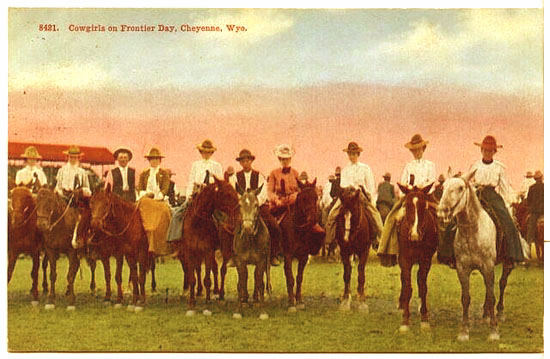
Cowgirls at Frontier Days, 1904
Women have participated in rodeos from the 1880's and in Frontier Days from at least
1904 when Bertha Kaepernick (Mrs. Dell Blancett) gave an exhibition of bronc riding.
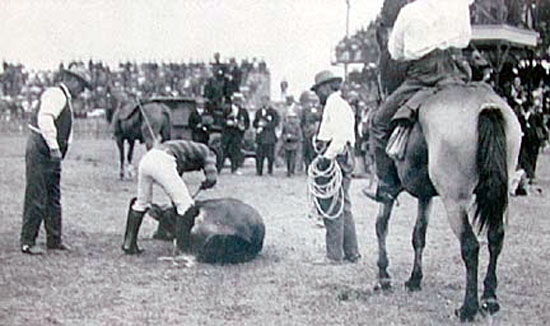
Ikua Purdy in Steer Roping Contest, Frontier Day, 1908
By 1908, the show was recognized as the premier rodeo in the United States surpassing the Pendleton Roundup and
attracting cowboys from
as far away as Hawaii. That year, Eban "Rawhide Ben" Low, a Hawaiian rancher paid the
steamer and rail fare for three paniolos, Hawaiian cowboys (Ikua Purdy,
Archie Ka`aua, and Jack Low), to enter the Cheyenne rodeo. Over coming the fact
that Ka`aua had a lame arm and Low had come down with an attack of asthma,
the result came as a shock.
The Cheyenne Daily Leader reported in a front page story:
ROPERS FROM HAWAII CAUSE SENSATION
Two brown Kanakas from Hawaii provided the big sensation at Frontier Park
yesterday [Aug. 21] -- Iku Purdy and Archie Tiini, lithe youngsters from
the far Pacific, invaded the heart of the American cow country and taught
the white ropers a lesson in how to handle steers.
The paper indicated, however, that in the end the idea of Hawaiians winning did not
sit well:
Here was something new -- the idea of a Hawaiian cowboy defeating a real
cowboy at the cowboy's own particular game -- and the crowd made the most
of the novelty. Their performance took the breath from the American cowboys,
and [they] are demanding that the whites who are to rope today
let slip no opportunity to beat the time of the Honolulu experts.
The next day the paper reported the result and corrected the spelling of the names:
WYOMING LOSES BOTH CHAMPIONSHIP TITLES
Ikua Purdy of Hawaii New Steer Roping Champion and Dick Stanley of Oregon New Broncho Busting Champion.
Purdy placed first with a time of 1 minute 6 seconds [Webmaster's note: One source indicates
a time of 56 seconds.], beating Hugh Clark, the 1904 bronco breaking champion. Ka`aua placed third and Low sixth.
Prior to his death Purdy (1873-1945) served for
twenty-four years as foreman of the Ulupalakua Ranch in Hawaii. He was inducted into the
Rodeo Cowboy Hall of Fame in 1999. Today, over ninety years later in the distant Pacific, they still sing of Waiomina, Wyoming (Words at
bottom of page).
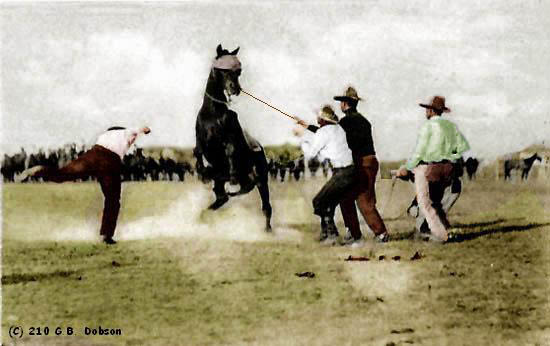
Saddling an Outlaw, Frontier Days, 1910.
In the early years of rodeo, chutes were not used and the broncs were saddled in the arena. The horse
would be blindfolded, saddled and held down until the rider could mount. In the following two
photographs taken moments apart, the handlers approach the horse. The rider is the one wearing the woolies.
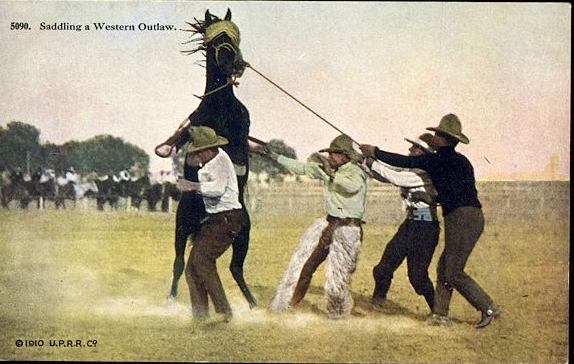
Saddling an Outlaw, Frontier Days, 1910.
Many broncs are trained to get away from a rider after the rider has been
thown. From a technical viewpoint, an "outlaw" refers to a bronc that will attempt to
trample the rider. In the 1910 Frontier Days, C. B. Irwin was severely hurt while assisting in the
saddling of his bronc Silver City to be ridden by Hoot Jones.
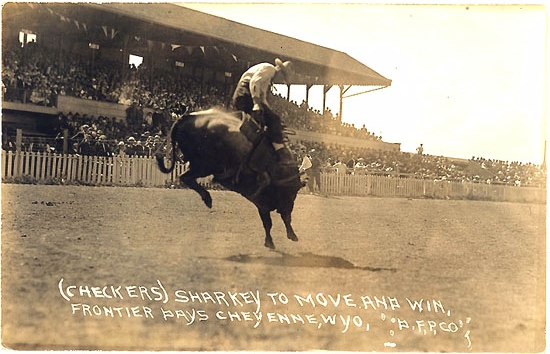
Sharkey the famous bucking bull, photo by Ralph Doubleday.
Other animals besides horses were also stars. In addition to Frontier Days, Sharkey appeared
at other shows. One of Ralph Doubleday's more famous photos is one of
Sharkey at Pendleton throwing Tuck Reynolds.
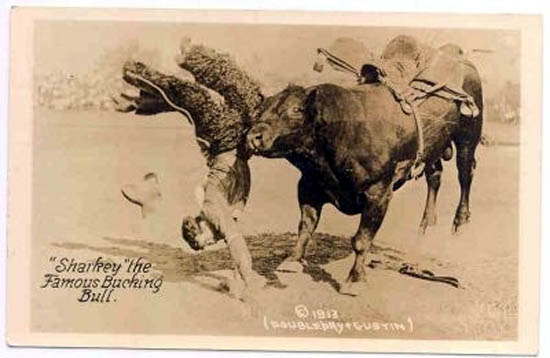
Sharkey throwing Tuck Reynolds, Pendleton, 1913, photo by Ralph Doubleday.
Waiomina (Wyoming) - by Helen Parker
Kaulana Ikuwa me Ka`au`a, lä
Na `eu kïpuka `ili
Na äiwaiwa `o Eulopa, lä
Waimea e ka `eu
Ka ua Kïpu`upu`u
Kahua Waiomina
`Olua nä moho puna ke ao, lä
Na `eu kipuka `ili
`A`ohe kupu`eu nanä e a`e, lä
Waimea e ka `eu
Ka ua Kïpu`upu`u
Meke anu a`o Kaleponi
Na ke kelekalapa i ha`i mai, lä
Na `eu kïpuka `ili
Ikuwa e ka moho puni ke ao, lä
Waimea e ka `eu
Ka ua Kïpu`upu`u
Na kuahiwi `ekolu
Piha hau`oli ou mau kini, lä
Na `eu kïpuka `ili
Kaulana ka ua Kïpu`upu`u, lä
Waimea e ka `eu
Na kuahiwi `ekolu
Kahua Waiomina
Ha`ina hou mai ka puana, lä
Na `eu kïpuka `ili
Ke kaula `ili a`o kani ka uwepa, lä
Waimea e ka `eu
Na kuahiwi `ekolu
Waimea e ka `eu
|
Famous are Ikuwa and Ka`au`a
Both mischievous with the lariat
Both experts in Europe
Waimea full of gusto
The hard rain named Kipu`upu`u
To the stadium of Wyoming
Both are delegates to the world championship
Both mischievous with the lariat
No expert to excel you
Waimea full of gusto
The hard rain named Kipu`upu`u
To the cold of California
A telegraph brought us the word
Of your mischievous lariats
Ikuwa is the champion of the world
Waimea full of gusto
The hard rain named Kipu`upu`u
And the three mountains
Your people are full of happiness
Of your mischievous lariats
Famous is the Kipu`upu`u rain
Waimea full of gusto
The three mountains
The stadium of Wyoming
Tell the refrain
Of your mischievous lariats
The sound of the lariats
Waimea full of gusto
The three mountains
Waimea full of life |
Next page, Frontier Days continued, Steamboat.
|